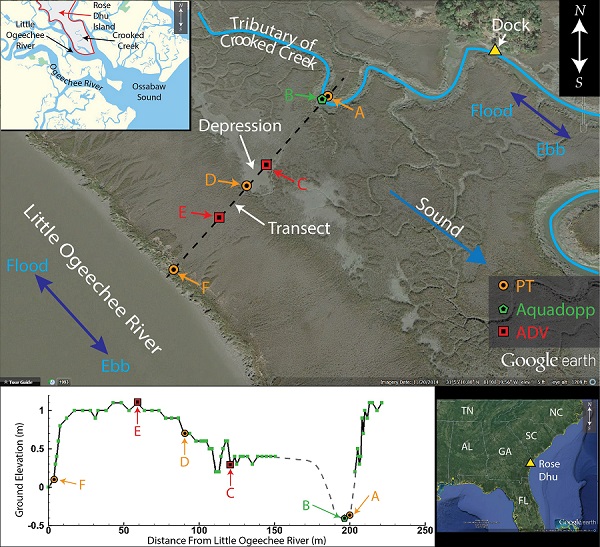Current velocity at station E at an oyster reef in Wassaw Sound, Georgia in November of 2014 (SensoryNCE project)
Project
| Contributors | Affiliation | Role |
|---|---|---|
| Weissburg, Marc | Georgia Institute of Technology (GA Tech) | Principal Investigator |
| Kubanek, Julia | Georgia Institute of Technology (GA Tech) | Co-Principal Investigator |
| Webster, Donald | Georgia Institute of Technology (GA Tech) | Co-Principal Investigator, Contact |
| York, Amber D. | Woods Hole Oceanographic Institution (WHOI BCO-DMO) | BCO-DMO Data Manager |
This dataset contains velocity measurements at an intertidal and subtidal oyster reefs in Wassaw Sound, Georgia from November 3rd to 6th, 2014.
These data were published in Young et al., 2016 (see Fig. 3)
In addition to the "Get data" button above which provides various options to download the data in ASCII format, the originally submitted data is available in MATLAB .mat format (FinalADV07_11032014.mat, 346 KB)
A subset of these data corresponding to Figure 3 in Young et al., 2016 can be downloaded as (ADV_E_Velocity_11032014.mat, 203 KB)
The equipment used is an Acoustic Doppler Velocimeter (ADV, Nortek Vector – Nortek AS, Rud, Norway). ADVs measure the fluid velocity at essentially a point in the flow. The ADV measurements have a resolution of 1 mm/s and were collected continuously at 1 Hz.
Sampling Location Map:
Image courtesy of David Young
Data collected during low tide (determined by instances of the PT at station D being dry) were discarded. Following the recommendations of Chanson et al. (2008) and Wilson et al. (2013), data for which the average correlation coefficient of the three beams was less than 70% for 45 consecutive samples, or for which the average over 300 samples of the mean correlation coefficient of the three beams dropped below 70%, were discarded. This filtering predominately removed data collected while the instrument was not submerged, and less than 2% of the submerged instrument data were removed due to filtering.
BCO-DMO Data Manager Processing Notes:
* added a conventional header with dataset name, PI name, version date
* data extracted from MATLAB .mat files to ASCII flat files to serve in the BCO-DMO system
* modified parameter names to conform with BCO-DMO naming conventions
* added approximate lat and lon of sampling location to data
* data rounded to three decimal places
* Time format changed from matlab datenum to Date and Time (yyyy-mm-dd,HH:MM:SS)
* Data version 2 (2018-07-12) replaces data version 1 (2017-07-20) - improved metadata, added timestamp in UTC in addition to local date/time
| File |
|---|
ADV_E.csv (Comma Separated Values (.csv), 1.64 MB) MD5:c27840a5be1d94c043cf5447ced22d27 Primary data file for dataset ID 709379 |
| Parameter | Description | Units |
| date | Date (local EST) in format yyyy-mm-dd | unitless |
| time | Time (local EST) in format HH:MM | unitless |
| velocity_mag | Velocity magnitude | centimeters per second(cm/s) |
| velocity_dir | Velocity direction; angle relative to east | radians |
| lat_approx | Approximate latitude | decimal degrees |
| lon_approx | Approximate longitude | decimal degrees |
| ISO_DateTime_UTC | Timestamp (UTC) in standard ISO 8601:2004(E) format YYYY-mm-ddTHH:MM:SSZ | unitless |
| Dataset-specific Instrument Name | ADV, Nortek Vector |
| Generic Instrument Name | Acoustic Doppler Velocimeter |
| Dataset-specific Description | Acoustic Doppler Velocimeter (ADV, Nortek Vector – Nortek AS, Rud, Norway). |
| Generic Instrument Description | ADV is the acronym for acoustic doppler velocimeter. The ADV is a remote-sensing, three-dimensional velocity sensor. Its operation is based on the Doppler shift effect. The sensor can be deployed either as a moored instrument or attached to a still structure near the seabed.
Reference:
G. Voulgaris and J. H. Trowbridge, 1998. Evaluation of the Acoustic Doppler Velocimeter (ADV) for Turbulence Measurements. J. Atmos. Oceanic Technol., 15, 272–289. doi: http://dx.doi.org/10.1175/1520-0426(1998)0152.0.CO;2 |
SensoryNCE_2014
| Website | |
| Platform | Wassaw_Sound_GA |
| Start Date | 2014-11-03 |
| End Date | 2014-11-06 |
| Description | Wassaw Sound, Georgia |
The role of the sensory environment and predator chemical signal properties in determining NCE strength in cascading interactions on oyster reefs (SensoryNCE)
Extracted from the NSF award abstract:
In this project, the investigators will examine the ability of top blue crab predators to indirectly benefit the abundance of basal oyster prey by reducing the density (consumptive effects, CEs) and suppressing foraging (non-consumptive effects, NCEs) of intermediate mud crab predators. These NCEs are mediated by chemical perception of aversive cues in blue crab urine and produce a behaviorally mediated trophic cascade. Through a series of manipulative experiments, the investigators will examine how the strength of this behaviorally-mediated trophic cascade is modulated and factors that influence perceptive range such as predator diet and intake rate, and the flow environment. The investigators will also determine the chemical identity, concentration and release rate of chemical cues.
Identifying the quantitative and molecular aspects of aversive cues, and linking them to behavioral responses that produce trophic cascades establishes the chemical basis of risk perception by prey and how this translates into cascading ecological effects. The use of perceptive range as a framework for evaluating the effects of both chemistry and environment provides an integrated view of processes affecting chemically-mediated NCEs. The use of a water borne predator-prey signaling system to test ideas on the strength of NCEs should have broad applications.
| Funding Source | Award |
|---|---|
| NSF Division of Ocean Sciences (NSF OCE) |
[ table of contents | back to top ]
